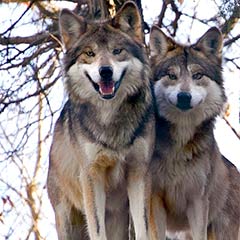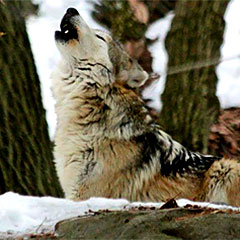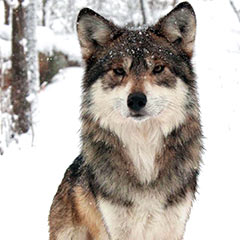
Mexican Gray Wolf
Mexican Gray Wolf Conservation
Zoo New England is committed to re-introducing Mexican gray wolves into the wilds of the American Southwest, where they once lived in large numbers.





Mexican Gray Wolf
Zoo New England is committed to re-introducing Mexican gray wolves into the wilds of the American Southwest, where they once lived in large numbers.
Since 1998, Zoo New England has been committed to re-introducing Mexican gray wolves into the wilds of the American Southwest, where they once lived in large numbers. Stone Zoo is one of about 51 facilities across the country and in Mexico participating in the Mexican Wolf Survival Plan (SSP). We've overseen births of these rare animals at Stone Zoo and collaborated closely with other facilities to transfer and receive wolves on their journey to being re-introduced to the wild.
Zoo New England participates in the SAFE Mexican Wolf initiative, a cross-border recovery program aimed at fostering collaboration with local communities in the recovery regions of Mexico and the United States. Through partnerships with the U.S. Fish and Wildlife Service, AZA-accredited institutions, and other stakeholders, SAFE Mexican Wolf actively promotes conservation endeavors for the preservation of this species.
This year we're launching an exciting new initiative with a suite of partners in Mexico to work with ranchers south of the border to improve their willingness to allow wild wolves on their land. This will be done through innovative education and incentive efforts that have been tested in other programs (for example, our Northern Jaguar Project, also in Mexico). Given that the biggest threat to the recovery of Mexican gray wolves is the killing of wolves by ranchers to protect their livestock, the success of this initiative will go a long way toward helping the Mexican gray wolf come back. ZNE is currently the sole US-based partner on this project and our support will be pivotal to getting Mexico's long-awaited coexistence initiatives off the ground. We hope to encourage other zoos to join us in this important endeavor.
The Mexican gray wolf (Canis lupus baileyi), also known as “el lobo” in Spanish, was once common throughout western Texas, southern New Mexico, central Arizona and northern Mexico. But by the mid-1900s they were eliminated from the wild in the U.S., victims of eradication efforts to prevent them from preying on livestock. They survived here only in small captive populations, and in Mexico their population also dwindled dramatically.
Great strides have been made to grow the Mexican gray wolf population and reintroduce them into the wild. In 1976, they were listed as endangered under the Endangered Species Act. The Mexican wolf recovery team was formed and a conservation and survival plan was established in 1979.
Nearly extinct by the mid-1900s, the wild Mexican Gray Wolf population is slowly coming back from the brink of extinction through the work of the Mexican Wolf SSP and other organizations.
Institutions currently participating in the SSP (including Stone Zoo) house approximately 350 wolves. The SSP’s goal is to maintain at least 240 animals in captivity at all times to ensure the security of the species, while still being able to breed animals for reintroduction.
For the first time since reintroduction into the wild, the population of Mexican wolves in Arizona and New Mexico has surpassed 200. Recent counts by the U.S. Fish and Wildlife Service documented a minimum of 241 wild Mexican wolves in 2022 -- a 23 percent increase from the previous year. This marks the seventh consecutive year of growth in the wild population.
Over half of the wild Mexican wolf population is now monitored through radio collars using satellite technology to record their location. Wildlife biologists use this information to gain timely information about wolf behavior in the wild and assist with management of the wild population.
While this growth is encouraging, re-establishing the Mexican gray wolf population continues to be a slow and complex process, and Zoo New England is unwavering in its commitment to the future of this rarest of wolves.
➤ Visit Stone Zoo to learn more about wolves and support our conservation efforts.





